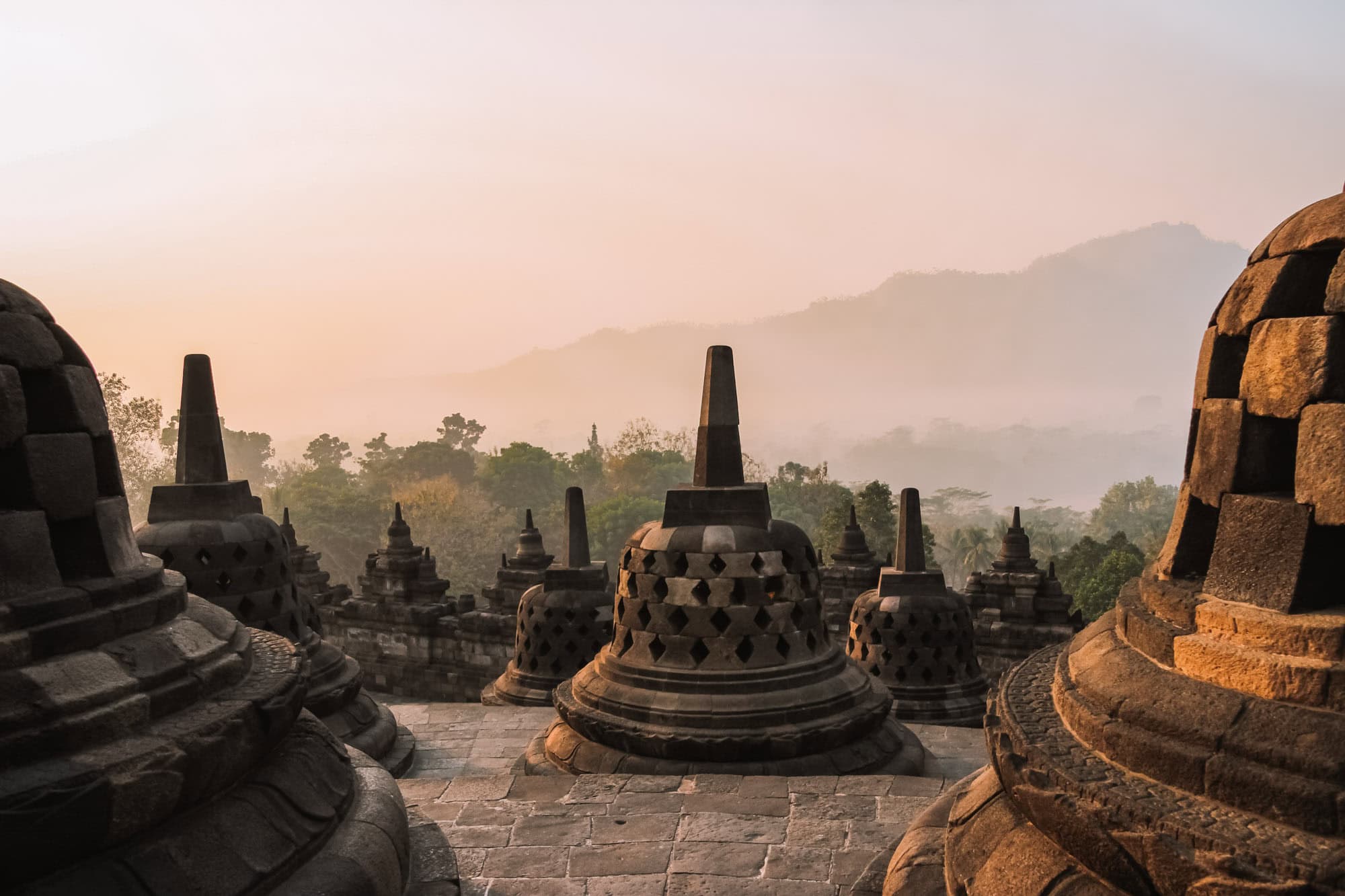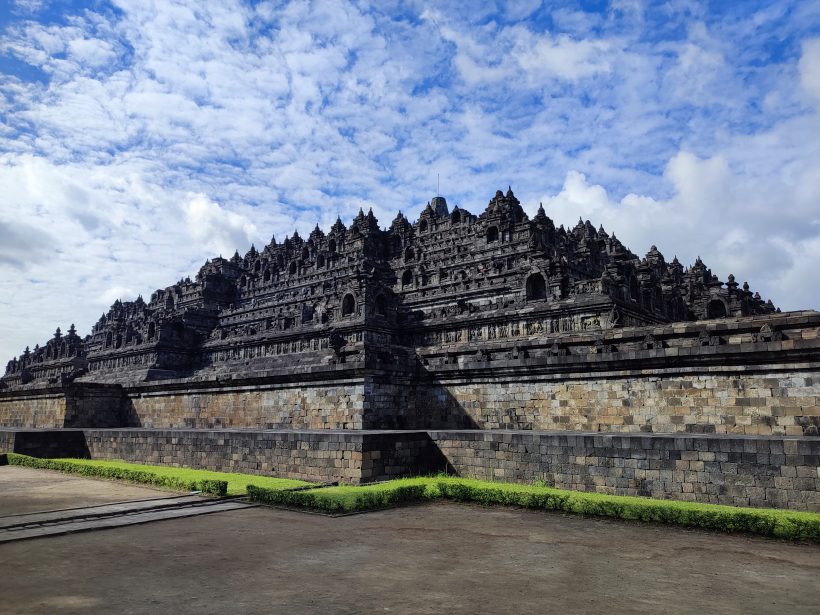
Borobudur Temple, a UNESCO World Heritage site, stands as a colossal monument to Buddhist spirituality and ancient Javanese artistry. Rising majestically from the lush plains of Central Java, Indonesia, this 9th-century marvel beckons travelers with its intricate carvings, serene atmosphere, and profound historical significance. More than just a tourist destination, Borobudur is a journey into the heart of a spiritual mandala, inviting contemplation and awe. This comprehensive guide will equip you with everything you need to know for an unforgettable pilgrimage to this iconic landmark.
A Glimpse into Borobudur’s Storied Past
The story of Borobudur is as fascinating as its architecture. Constructed by the Sailendra dynasty, likely between 770 and 850 AD, its exact purpose remains a subject of scholarly debate. However, it is widely believed to be a Mahayana Buddhist temple and a place of pilgrimage, designed to represent the Buddhist cosmology and guide devotees through stages of enlightenment.
Related Articles about Journey to the Sacred Mandala: Your Ultimate Guide to Borobudur Temple:
- Unveiling the Majesty: Top Things to Do in the United Kingdom
- Cambodia: A Jewel of Southeast Asia – Your Comprehensive Travel Guide
- A Tapestry of Time and Beauty: Unveiling the Best Tourist Attractions in the Czech Republic
- Bangkok Unveiled: A Comprehensive Travel Guide to the City of Angels
- Johannesburg: Unveiling the Heart of South Africa – Top Hotels & Beyond
The temple’s name itself is shrouded in mystery. Some theories suggest it derives from the Sanskrit "Vihara Buddha Uhr," meaning "monastery of the Buddha on the hill," while others link it to the local word "Boro," referring to a village, and "Budur," potentially meaning "monastery."
For centuries, Borobudur lay hidden, gradually being reclaimed by nature and volcanic ash. Its rediscovery in the early 19th century by the British Lieutenant-Governor of Java, Sir Thomas Stamford Raffles, marked the beginning of its revival. Extensive restoration efforts, most notably in the 1970s and 1980s with UNESCO’s support, have painstakingly brought the temple back to its former glory, allowing us to marvel at its intricate beauty today.
Unveiling the Main Attractions: A Sacred Journey Through Levels
Borobudur is not a single structure but a monumental tiered pyramid built on a hill. It comprises nine stacked platforms: six square terraces at the base, topped by three circular terraces. The entire structure is adorned with over 2,600 relief panels and 504 Buddha statues.
1. The Base Terraces (Kamadhatu and Rupadhatu): The World of Desire and Form
The lower six square terraces, collectively known as Rupadhatu, depict scenes from the Jataka tales (stories of the Buddha’s previous lives), the Avadanas (stories of ordinary people achieving enlightenment), and the Lalitavistara (the life of the Buddha). These reliefs are a visual narrative of Buddhist teachings, moral lessons, and the journey towards spiritual awakening.
- The Hidden Foot (Kamadhatu): Beneath the lowest level of Rupadhatu lies a hidden relief panel, the Kamadhatu, believed to depict scenes of earthly desires and karmic consequences. While not publicly accessible, its existence hints at the deeper philosophical layers of the temple.
- The Narrative Reliefs: As you ascend, each panel tells a story. Take your time to observe the intricate details of the carvings – the flora, fauna, human figures, and architectural elements that bring these ancient narratives to life. Look for the famous "relief of the woman carrying a child" and the depiction of everyday Javanese life.
2. The Upper Terraces (Arupadhatu): The Realm of Formlessness
The three circular terraces, known as Arupadhatu, represent the transition to the formless realm of enlightenment. These terraces are simpler, adorned with perforated stupas, each housing a statue of the Buddha.
- The Circular Platforms: The transition from square to circular platforms symbolizes the shedding of earthly attachments and the move towards spiritual transcendence.
- The Stupas: The numerous perforated stupas are a signature feature of the upper levels. The holes allow glimpses of the Buddha statues within, signifying the omnipresence of enlightenment.
- The Great Central Stupa: At the very summit lies a large, hollow central stupa. It is believed to represent Nirvana, the ultimate state of liberation. While the entrance is sealed, its presence is a powerful symbol.
3. The Buddha Statues:
Scattered throughout the temple, particularly on the upper terraces, are 504 seated Buddha statues. Each statue is in a different mudra (hand gesture), symbolizing various aspects of the Buddha’s teachings. The most common mudra is the Bhumisparsha Mudra, where the Buddha touches the earth, signifying his enlightenment and victory over temptation.
4. The Panoramic Views:
Beyond its spiritual and historical significance, Borobudur offers breathtaking panoramic views of the surrounding landscape. From the upper levels, you can see the verdant rice paddies, the distant Menoreh Mountains, and, on a clear day, the silhouettes of volcanoes like Mount Merapi and Mount Merbabu. The sunrise and sunset vistas from Borobudur are particularly iconic and awe-inspiring.
Essential Travel Tips for Your Borobudur Adventure
To make your visit to Borobudur a smooth and enriching experience, consider these practical tips:
-
Getting There: Borobudur is located approximately 40 kilometers northwest of Yogyakarta. You can reach it by:
- Private Car/Taxi: This is the most convenient option, offering flexibility and direct transport. Negotiate the fare beforehand.
- Grab/Gojek: Ride-hailing apps are readily available in Yogyakarta and can be used to book cars or motorcycles.
- Public Bus: Buses depart regularly from Yogyakarta’s Jombor Bus Terminal to Borobudur. This is the most budget-friendly option but takes longer.
- Organized Tours: Many tour operators in Yogyakarta offer day trips to Borobudur, often including other nearby attractions.
-
Tickets and Entrance: Purchase your tickets at the official ticket counter upon arrival. Consider buying a combined ticket if you plan to visit other nearby temples like Prambanan and Ratu Boko.
-
Best Time to Visit:
- Sunrise/Sunset: These are the most popular times due to the stunning visual spectacle. Arrive early to secure a good spot and beat the crowds. Sunrise tours often include special access to the temple grounds before the official opening.
- Early Morning (before 9 AM): The crowds are thinner, and the air is cooler, making it ideal for exploring the reliefs.
- Late Afternoon (after 3 PM): The golden hour light is beautiful for photography, and the crowds begin to thin as the day ends.
- Avoid Peak Hours: Mid-morning and early afternoon can get very crowded, especially during peak tourist seasons.
-
What to Wear:
- Comfortable Footwear: You’ll be doing a lot of walking and climbing.
- Light, Breathable Clothing: Central Java can be hot and humid.
- Modest Attire: As a sacred site, it’s respectful to cover your shoulders and knees. Sarongs are often available for rent or can be purchased nearby if needed.
- Hat and Sunglasses: For sun protection.
-
What to Bring:
- Water Bottle: Stay hydrated, especially in the heat.
- Sunscreen: Protect your skin from the sun.
- Camera: To capture the magnificent architecture and views.
- Small Backpack: To carry your essentials.
- Insect Repellent: Especially if you’re visiting during the wet season.
-
Respectful Conduct:
- Quietude: Maintain a respectful silence as it is a place of worship.
- No Touching: Avoid touching the reliefs or statues.
- No Smoking or Eating: These are prohibited within the temple complex.
- Dress Modestly: As mentioned above, dress respectfully.
-
Guided Tours: Consider hiring a local guide at the entrance. They can provide invaluable insights into the history, symbolism, and intricate details of the temple, enriching your understanding and appreciation.
-
Sunrise and Sunset Experiences:
- Sunrise: Many hotels and tour operators offer early morning access packages that allow you to witness the sunrise from the temple grounds. This is a magical experience, with the mist rising from the valleys and the first rays of sun illuminating the stupas.
- Sunset: The changing colors of the sky during sunset cast a warm glow on the temple, creating a serene and beautiful atmosphere.
Nearby Hotels: Comfort and Convenience
Yogyakarta is the primary gateway to Borobudur, offering a wide range of accommodation options. For a more immersive experience, consider staying closer to the temple.
Luxury:
- Plataran Borobudur Resort & Spa: Offers stunning views of Borobudur and luxurious amenities.
- The Manohara Resort: Located within walking distance of the temple, providing unparalleled access.
Mid-Range:
- Amanjiwo: A luxurious retreat with a focus on wellness and tranquility, a short drive from Borobudur.
- Hotel Borobudur: A comfortable option offering good amenities and proximity to the temple.
Budget:
- Various guesthouses and homestays are available in the villages surrounding Borobudur, offering a more authentic local experience.
Yogyakarta City: If you prefer a wider selection of hotels and amenities, staying in Yogyakarta city is a great option. It offers everything from budget hostels to international hotel chains.
A Taste of Javanese Cuisine: Local Delights
Exploring Borobudur is also an opportunity to savor the flavors of Javanese cuisine.
- Nasi Goreng: The ubiquitous Indonesian fried rice, a flavorful and satisfying staple.
- Gudeg: A traditional Javanese dish made from young jackfruit stewed in coconut milk and palm sugar. It’s often served with rice, chicken, and a hard-boiled egg.
- Sate Ayam/Kambing: Grilled skewers of chicken or lamb, marinated in spices and served with peanut sauce.
- Bakso: A savory meatball soup, a popular street food.
- Tempe: A fermented soybean cake, a healthy and versatile ingredient used in various dishes.
- Local Coffee: Javanese coffee is rich and aromatic. Don’t miss trying it.
You can find these dishes at local warungs (small eateries), restaurants, and street food stalls. When dining near Borobudur, try the local specialties for an authentic culinary experience.
Transportation Options: Navigating the Region
Beyond getting to Borobudur, understanding transportation options in the region is crucial.
-
Within Yogyakarta:
- Taxis and Ride-Hailing Apps: Readily available for convenient travel within the city.
- Becak: A three-wheeled bicycle taxi, a charming way to explore shorter distances.
- Andong: Horse-drawn carriages, offering a traditional and scenic ride.
-
Exploring Beyond Borobudur:
- Car Rental with Driver: Ideal for exploring multiple attractions in Central Java at your own pace.
- Scooter Rental: For independent travelers who are comfortable riding in traffic.
- Organized Day Tours: As mentioned earlier, these are a convenient way to visit multiple sites like Borobudur, Prambanan, and other attractions in a single day.
Beyond Borobudur: Extending Your Journey
While Borobudur is the undisputed star, the surrounding region offers more to explore:
- Prambanan Temple: Another UNESCO World Heritage site, this magnificent Hindu temple complex is a must-visit.
- Ratu Boko Palace: An archaeological site with stunning sunset views and remnants of a royal palace.
- Mount Merapi: For the adventurous, a jeep tour or hike on the slopes of this active volcano offers an exhilarating experience.
- Dieng Plateau: Known for its ancient temples, crater lakes, and cool mountain air.
- Local Villages: Explore the villages around Borobudur to witness traditional Javanese life and crafts.
Conclusion: A Spiritual and Architectural Masterpiece
Borobudur Temple is more than just a collection of ancient stones; it is a testament to human ingenuity, spiritual devotion, and artistic mastery. A journey here is an opportunity to connect with history, immerse yourself in Buddhist philosophy, and witness a breathtaking architectural marvel. By planning your visit with these tips in mind, you can ensure a meaningful and unforgettable experience at this sacred mandala, a true gem of Indonesia and the world. So, pack your bags, open your mind, and prepare to be captivated by the magic of Borobudur.








